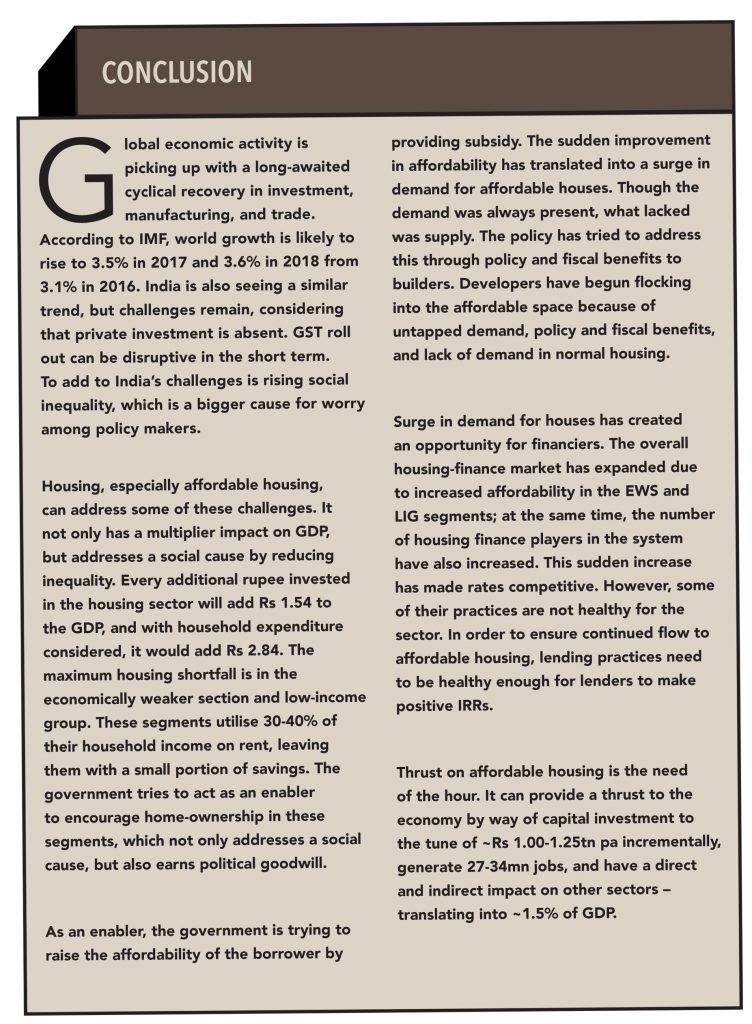As per India Ratings’ estimates, the housing-for-all scheme has the potential to push up India’s economy by 3.5% by 2022, with sectors supplying crucial inputs to the construction industry being the biggest beneficiaries. Sectors such as cement, iron, and steel – crucial inputs in construction – are likely to be the biggest beneficiaries of the HFA programme.
In its study on the impact of housing on India’s GDP, National Council of Applied Economic Research had highlighted the following findings:
• Residential construction (housing sector) accounts for (1) 1.24% of the total output of the economy (total construction sector is 11.39%). (2) 1% of GDP (total construction sector is 8.2%), (3) 6.86% of employment (total construction sector is 11.52%).
• Housing is the fourth-largest employment-generating sector in India.
• 99.41% of jobs in the housing sector are informal.
• Its labour-to-output ratio, i.e., the number of persons employed to produce 100,000 units of output, is 2.34, the highest among all sectors.
• The type-1 output multiplier for the housing sector is 2.33 and type-2 is 5.11, i.e., an increase of one unit in the final demand for housing translates into induced cumulative revenues of 5.11 units in the economy.
• For every Rs 100,000 invested in the housing sector, 2.69 new jobs (2.65 informal and 0.4 formal) are created in the economy. With induced effect, the number of jobs created would be 4.06 (3.95 informal and 0.11 formal).
• For every investment in the housing sector, household income increases by Rs. 0.41. With induced effect, this is estimated to be Rs. 0.76.
• For every unit of housing created, household income increases by 0.41 units. With induced effect, this is estimated to be 0.76 units.
• Type-1 income multiplier for housing sector is 1.54 and type-2 is 2.84. This would mean that a unit of increase in the final expenditure in this sector would generate additional income as high as 3 times the income generated within the housing sector itself.
• Every additional rupee invested in the sector will add Rs 1.54 to the GDP, and with household expenditure considered, it will add Rs 2.84.
• For every rupee invested in creating housing, Rs 0.12 is collected as indirect taxes.
The impact of housing is visible in other segments too. GV tried to look at the beneficiaries of the housing boom in other sectors. Cement is a direct play in housing. Developers use portable grade-53 cement in construction and beneficiaries are branded cement players, as this is not a fragmented industry. However, the benefits can vary from area to area, depending on the shortfall. Out of the total short-fall calculated by the TG-12 group, Uttar Pradesh constitutes the largest at 3.1mn units. With the centre and state government aligning with each other, major investment can flow towards housing in Uttar Pradesh, which until now was absent. Hence, north-based cement players could turn out to be key beneficiaries.
In affordable housing, other inputs such as tiles, ceramics, paints, wire & cable, and PVC pipes are dominated by unbranded players due to prevalent cost benefits. On the services side, lenders make term and property insurance mandatory (for homes loan) in order to protect their exposure. Hence, penetration of financial services should see a significant jump in the next five years.
The housing-for-all scheme has the potential to push up India’s economy by 3.5% by 2022, with sectors supplying crucial inputs to the construction industry being the biggest beneficiaries

Subscribe to enjoy uninterrupted access